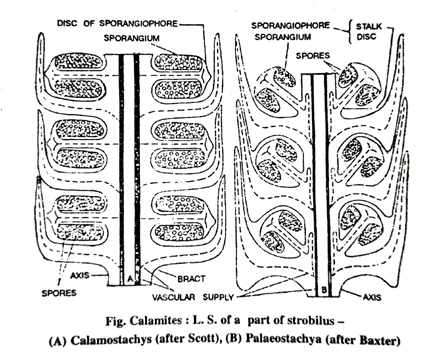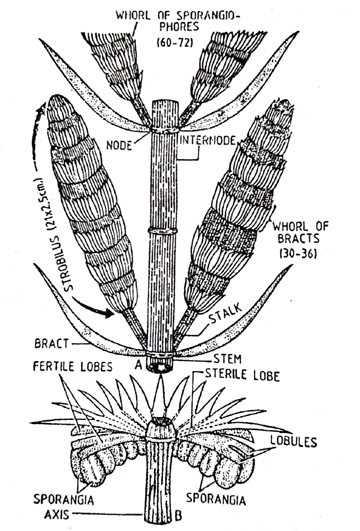Give an account of different types of strobili found in Calamites.
Q. Give an account of different types of strobili found in Calamites.
Or, Give a comprehensive account of common cone general of Calamites.
Ans. The strobili associated with the Calamitean stem are given the name Calamostachys. In this, the strobilus had a central axis bearing whorls of sporangiophores. Alternating with the whorls of sporangiophores were whorls of sterile appendages called bracts. The sporangiophores had cruciately branched apices. The tip of each branch recurved towards the strobilar axis and had a sporangium at the tip. The genus Calamostachys had both homosporous and heterosporous species. The strobilus had both the types of sporangia in heterosporous forms.
Strobilus carrying the verticels of bracts and sporangiophores. Based on the relative position of bracts and sporangiophores, strobilus genera are of following types:
(a) Calamostachya : Bracts and sporangiophores were placed alternately. Basically bracts were fused to form saucer-like structure, and their number was just double the number of sporangiophores. Both of these were separate structures having their own vascular supply. Sporangiophores stood at right angle to the strobilus axis.
The strobilus was normally homosporous but heterosporous in C. casheana. The shield-like peltate disc of a sporangiophore had sac-like four sporangia, each bearing a uniseriate jacket.

The vascular supply in the axis was continuous throughout.
(b) Palaeostachya: Basically it was similar to Calamostachya except the sporangiophores which stood obliquely in the axil of sterile bracts. The peculiar course of vascular supply in the sporangiophores (shown in Fig) points out that they have moved downward from their original position to axillary one. Thus Palaeostachya evidently was a derived structure of Calamostachya.

Fig. Calamities: (A) Reconstruction of strobili of Macrostachya Thomsoni, (B) A sporangiophore of Cingularia typica (after Hirmer)
(c) Mazostachys: Here sporangiophores are borne in a whorl just below the vertical of bracts. The ratio of bracts to sporangiophores is 2:1, where a whorl of 12 bracts subtended by a whorle of 6 sporangiophores. The sporangiophores bear two pendant sporangia. The sporangiophore trace arose directly from the node before bending outward into the sporangiophore.
(d) Cingularia: In general, it resembles Mazostachys. Here both the whorls of bracts and sporangiophores are fused and develop horizontally. The sporangiophores are flat and bifurcate at their tips bearing four pendant sporangia.
(e) Calamocarpon: It is the most highly evolved cone among Calamites. In general organisation, calamocarpon resembles Calamostachys. The bracts to sporangiophores ratio is 1 : 1. There are variable numbers of bracts per whorl.
Each sporangiophore bears four sporangia. Calamocarpon shows true heterospory. The megasporangium contains a single functional megaspore surrounded by sterile tissue and epidermis which were shed from the cone as a unit
Follow on Facebook page – Click Here
Google News join in – Click Here
Read More Asia News – Click Here
Read More Sports News – Click Here
Read More Crypto News – Click Here